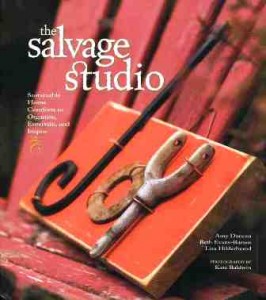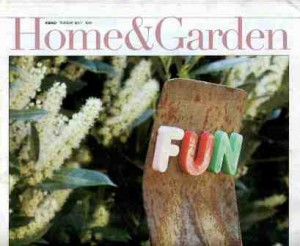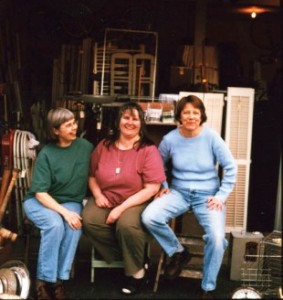Salvage Studio and Sustainable Design
October 4th, 2008
 If you’re seeking creative inspiration, or need a gift idea for that crafty person in your life, look no further than Salvage Studio of Seattle.
If you’re seeking creative inspiration, or need a gift idea for that crafty person in your life, look no further than Salvage Studio of Seattle.
My pals Beth Evans-Ramos, Lisa Hilderbrand and Amy Duncan share a “lust for rust” in their pursuit of sustainable design (to them, this means “reduce, reuse and recycle”) for the home, garden, and more. They teach classes at their studio in Edmonds, Washington, and frequently publish an idea-filled blog, also called Salvage Studio.
Just out, their new book, “The Salvage Studio: Sustainable Home Comforts to Organize, Entertain and Inspire” (Skipstone Books/Mountaineers, $21.95), is a compendium of the best salvage projects created and collected by these three gals over the past few years.
Imagine my delight when my review copy of The Salvage Studio arrived a few weeks ago. The attractive 8-1/4-inch x 9-1/4-inch book contains 200 gorgeous pages of great design ideas, tips for turning discarded items into decorative accents, step-by-step projects and more. I turned to the Acknowledgements page to find a thoroughly unexpected gift from the authors:
We are indebted to the writers and editors responsible for stories in the press, which helped immensely in spreading the word about our business and creative efforts. This includes Debra Prinzing, our number-one Fairy Godmother, author of numerous garden books and freelance writer extraordinaire. . .
I was so touched to read and receive this generous thanks. First of all, I am such a book-lover and publishing fanatic that I usually know an idea is a “hit” when I spot it. As soon as I met them, I knew that Beth & Co. were onto something, and in a very small way, I gladly shared with them my own experiences about the creative book process. They are three-fold fortunate, in that they worked with editor Kate Rogers, designer Karen Schober and photographer Kate Baldwin. This team turned a compelling idea in to a beautiful reality in words and visuals! I wish them the very best of success!
The publication of this book prompted me to pull out my files to look for the very first article I wrote about Beth and Lisa (this was before they met up with Amy, waiting on line at an estate sale, which is a magical tale retold in the introduction of The Salvage Studio).
 Here’s the cover of The Herald’s “Home & Garden” section from the first story about Beth and Lisa, May 6, 2004. It was titled “Art by the Yard,” a clever phrase coined by my editor Melanie Munk. I wrote:
Here’s the cover of The Herald’s “Home & Garden” section from the first story about Beth and Lisa, May 6, 2004. It was titled “Art by the Yard,” a clever phrase coined by my editor Melanie Munk. I wrote:
“Slightly rusted pieces of metal also appear in [Beth’s] garden, from old shovels to the grid from the back of a refrigerator. The metal allows her to spell out words of garden whimsy with children’s magnetic letters. ‘FUN,’ ‘REALITY’ and ‘WOW’ are some of her overt messages.”
Later, in 2006, after Salvage Sisters was formed and then morphed into Salvage Studio, I had the fortunate opportunity to write about Beth, Lisa and Amy for Sunset Magazine’s May 06 issue. I can’t find the FINAL version of the story (something about m-o-v-i-n-g to LA from Seattle that summer means I have a few MIA files/folders…), but here is the original text, written by moi about these Salvage Sisters extraordinaire:
At the Salvage Studio, everyday castoffs are transformed into artful accessories for the home and garden
By Debra Prinzing
(Sunset photographs shown here and below: from left, Beth Evans-Ramos, Lisa Hilderbrand, and Amy Duncan)
“Whenever I go to an estate sale, I head for the garage or basement first,” reveals designer Amy Duncan. While many collectors prefer rare antiques, this savvy scavenger understands that the best “raw materials” for her projects are hidden in cobweb-filled corners with rusty tools and other forgotten treasures.
“That’s where I can snag a really old atlas for four dollars, or a bunch of chipped enamelware. I know I can use old things in an interesting way,” Duncan explains.
One of three partners in the Salvage Studio, a Seattle collective for home and garden décor, Duncan met Beth Evans-Ramos while waiting on line for a country estate sale to open and the two quickly teamed up, along with fellow salvager Lisa Hilderbrand.
Kindred spirits in their search for vintage discards, the three realized they were onto something big in 2004 when their first garden art sale was nearly cleaned out. “We have just struck a gigantic chord,” says Evans-Ramos, known for her popular garden “towers” made from stacks of mis-matched teapots glued together. Followers of their “salvage style” appreciate one-of-a-kind accessories made from discards like bird cages, recycled glass lamp bases and metal bed frames. If things are abandoned or forgotten, Salvage Studio finds a new or better purpose for recycled materials.
“For years, I’ve been grabbing found objects to use in the garden,” adds Hilderbrand, a garden designer who has created a pond from a bathtub and fashioned a fountain from a lamp base for her own backyard.
These hunter-gatherers have an eye for beauty in what others might overlook. salvage studio’s success is built on the women’s ability to scout flea markets, thrift shops and estate sales for second-hand goods worthy of their unique, recycled art.
“If you’re a gardener, you’re really happy with others’ castoffs,” Evans-Ramos points out. “We’re already used to dividing and sharing our daylilies with other gardeners, so Salvage Studio is doing something similar with decor.”
For crafty types, Salvage Studio offers ongoing how-to classes. One recent half-day workshop showed students how to turn glass votive candleholders into creative three-dimensional paperweights.
Salvage Studio is open every Saturday, where shoppers will discover their lighthearted pieces assembled from slightly chipped and rusted found objects. You might notice a distressed iron candle holder, but look closely to detect its origins: a tractor part attached to a distressed pulley. The rust is authentic. The clever design? Complements of Salvage Studio.
Adorn and accessorize your garden with Salvage Studio-inspired designs. No two treasures are alike, so you can tailor each project to your own decorating style. Here are some of the women’s favorite projects:
Pretty platters: Evans-Ramos likes to jazz up bare spots in the landscape with assemblages of solid-and-patterned dishes. “I get saucers, dinner and salad plates for 99-cents or less at thrift stores,” she explains. It’s easy to mix-and-match a set of three plates. She glues together a stack using ‘Lawn and Garden Goop,’ glue found at home centers and craft stores. “If there are chips in the dishes, that’s even better,” Evans-Ramos chuckles. “I use regular plate holders and hang a vignette of three sets on a fence.” If they break? No problem, says her partner Duncan. “There’s always more where that came from.”
Spell a message: You can communicate words of garden cheer with children’s magnetic letters or discarded Scrabble pieces arranged across the blade of an old shovel or the center of a hubcap. JUNK, FUN, GROW, PLAY and BLOOM are some of salvage studios’ favorite words.
“Look at things and see what letters they resemble, too,” Hilderbrand suggests. She recently spelled out “JOY” using an old metal hook for “J,” the round top of a broken Christmas tree stand for “O,” and a twig that looks like a “Y.” Mounted on a weathered board, it’s a welcoming greeting for a front porch.
Store twine: Even if a teapot is missing its lid, it makes a useful holder for garden twine. Pop the ball of twine inside a chipped teapot and run the end of the string through the spout. Evans-Ramos sticks a pair of scissors inside, as well. Place several decorative but aging teapots around the garden where they’ll come in handy when it’s time to tie up a vine or branch.
Display art: Duncan converts sections of wire fencing into holders for photos, prints or even seed packets. To create the base, drill holes into a piece of molding or a fence picket and insert the wire fencing. “You can use old clothes pins to clip on the photos,” Duncan says.
I’m sending Beth, Lisa and Amy my very best wishes for a fabulous book launch. Their book party took place earlier today at their studio in Edmonds. I bet it was a great Salvage-Style celebration!
This little info box in their new book caught my eye. It offers simple encouragement for anyone who sees the beauty in the ordinary, utilitarian and humble objects of life:
Once a Day: Challenge yourself to find a new use for at least one thing a day
Turn your object upside down. What do you see? Discover an uncommon use for a common household item. Does a broom do anything besides sweep? Ask a friend to consider your things from her unique perspective; agree to live with his or her changes for at least 24 hours! Will your one thing fit into a larger work of art, a collection, or a display? Think “Green.” Is there a recycling alternative to just tossing something?










October 5th, 2008 at 9:21 am
One can never have too many ways to have fun in the garden!
October 5th, 2008 at 11:17 am
Thank you Debra for this absolutely wonderful review of our book! Your kind words mean so much. I admire you as an accomplished author and as such a supportive friend. I am very grateful for your support of our creative endeavors.
October 6th, 2008 at 6:38 am
WOW! How had I not heard of these lovely ladies before? I am going to run out to get this book! What a fun and inspiring treasure.
January 3rd, 2009 at 11:50 am
[…] rust” in my lede sentence. Credit must be given here to my friends Beth, Lisa and Amy of the Salvage Studio. It’s one of their […]
April 3rd, 2012 at 12:32 pm
[…] Debra Prinzing » Blog Archive » Salvage Studio and Sustainable …Reviews on Architectural salvage in Studio City – Silver Fox Architectural Salvage , Olde Good Things, Freeway Building Materials, North Hollywood Antiques, … […]